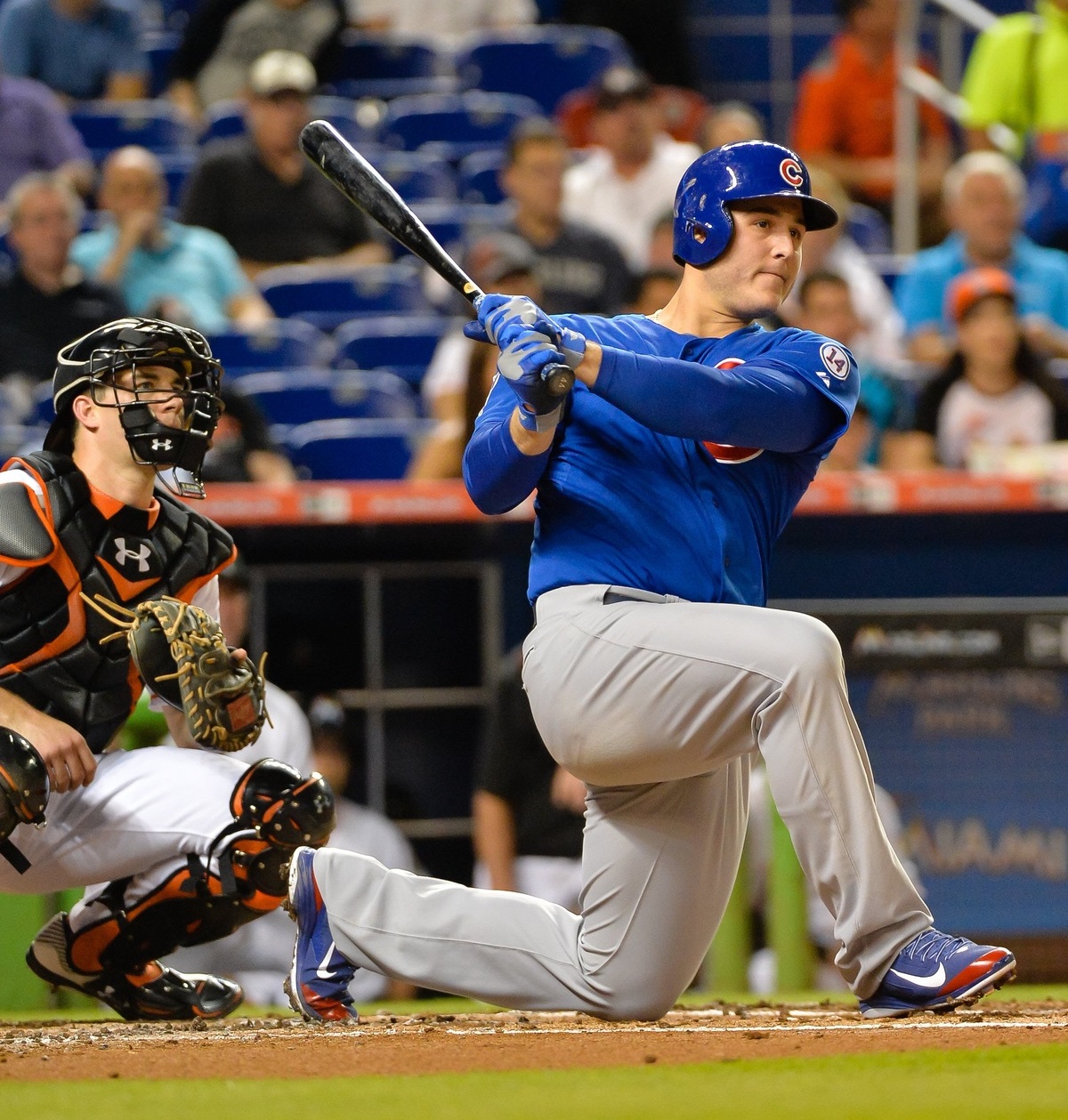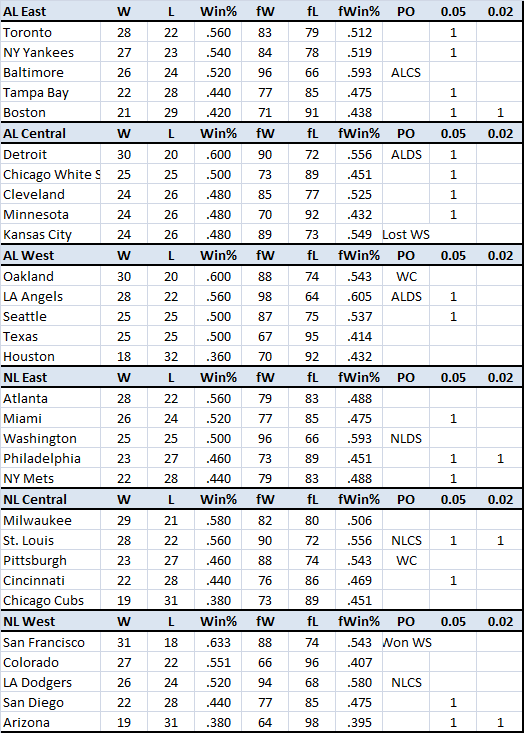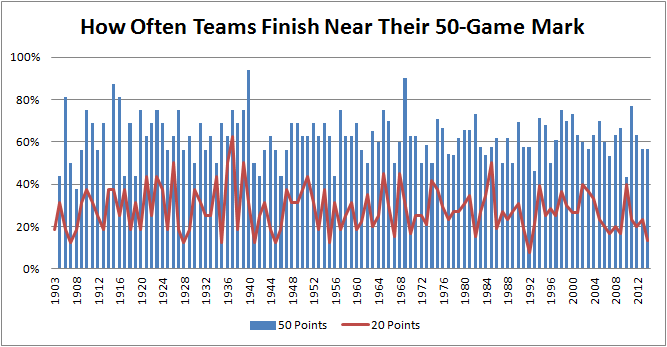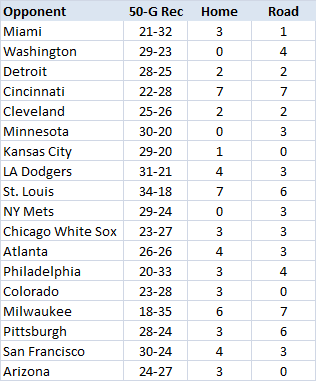As the Cubs has passed the 50-game mark, they’re approaching the point where questions begin to be answered, and not always in a positive manner. With a 27-23 record after Tuesday, the Cubs would be right in the thick of the playoffs if they were to begin now.
It’s not too soon to wonder if the Cubs could make the playoffs, because in baseball history, teams often finish close to their record after 50 games. This isn’t much of a surprise—good teams will have good records, bad teams will have bad ones, and the ones in the middle can be impacted by injuries, trades, call-ups, and other factors. This chart compares team records at the 50-game mark and their final record in 2014:
The .05 and .02 columns show if a team’s final record was within 50 points and 20 points, respectively, of their 50-game win percent.
This chart shows how often teams finish within 50 points of their 50-game mark (a swing of around ten games either way) or 20 points (around five games) since the inception of the World Series in 1903:
In 2014, the Cubs were 19-31 at the 50-game mark, a .380 winning percent and a dreadful team to watch. They made the obvious changes of calling up Arismendy Alcantara, Javier Baez, and Jorge Soler and showed marked improvement. There were winners—the Royals went on a second-half tear that eventually led to a World Series appearance, and for the second year in a row the Dodgers overcame a slow start to finish strong. There were disappointments as well, such as the Blue Jays and Brewers who couldn’t maintain strong starts. Past performance is never a 100-percent guarantee of the future, but it can be a useful gauge to see if it’s realistic to believe the Cubs have a reasonable shot of making the playoffs.
In 2014, 17 (around 60 percent) teams finished within 50 points of their 50-game win percent, and four (just under 20 percent) finished within 20 points. The 50-point measure is relatively stable in recent history, the 20-point far more volatile due to the narrower standard. Of course, a ten-game swing from .500 in either direction is the difference between massive change and one of the better records in a given year—these charts merely illustrate that by the time teams reach the 50-game mark, their true nature is often revealed.
Part of what will be the determining factor are the teams left on the Cubs schedule—this is their remaining schedule, along with those teams’ record after 50 games:
As of Tuesday, June 2, Baseball Prospectus playoff odds give the Cubs a 59.3 percent chance of making the playoffs, the fourth-best figure in the National League. They have 13 games left against the Cardinals, but also 27 between the Reds and Brewers.
On the field, things appear to be working out ahead of schedule, but there are causes for concern that need to be addressed, many of which I’ve discussed in prior BP-Wrigleyville posts. They continue to lead the majors in strikeouts, and while they are showing a far greater propensity to take walks than in the past, their .317 OBP is among the lowest among the teams with winning records. Their True Average is in the middle of the pack, and beyond Kris Bryant and Anthony Rizzo, it’s difficult to state who can be counted on to get important hits in clutch situations.
After a brief respite, the Cubs fielding woes have returned, and this simply needs to be fixed. Teams can’t win championships with good defense, but they sure can lose them with untimely errors. They’re in the middle of the pack using BP’s Defensive Efficiency, but it’s important to make distinctions between overall defense and individual plays. In the next couple of weeks, a decision is going to be made at shortstop, especially if Starlin Castro remains mired in a slump. With Javier Baez showing greater plate discipline at Triple-A Iowa, there will be three shortstops, a problem 29 other teams would love to have. I strongly suspect that before too long the Cubs will be playing Addison Russell at short, Baez at second, and Castro at third, displacing Bryant to left field.
The starting pitching has been everything it needs to be to keep them competitive. The easy thing is to look at the bottom of the rotation and say “Wow, they’re weak at no. 4 and no. 5 starters, they need to get someone in a trade.” Most teams are weak at the bottom, because if those pitchers were any good, they’d be no. 2 or no. 3 starters. Travis Wood has already been demoted to the pen, but Kyle Hendricks has performed well enough that only the last slot is an issue—for now. I would not be averse to the Cubs picking up another good starter like Cole Hamels, but I’m not desperate enough to suggest they give away the store in the process.
The bullpen is an entirely different manner. I did a podcast with fellow Beyond the Box Score writer Bryan Grosnick last week, and he brought up a most intriguing idea I had never considered before. We were discussing the bullpen in general, and closers specifically, and I stated I’ve always been interested in Glen Perkins of the Twins. We bandied that about for a bit, and then he suggested someone a little closer to home—Aroldis Chapman of the Reds. If you listen to the podcast you can hear my surprise very audibly, and it took me a couple of seconds to regain my composure.
It’s no secret that Chapman is a flamethrower, but sometimes it’s nice to put his numbers in perspective. To date, he’s thrown 409 pitches, of which 213, over half, are 99+ mph. Let that sink in—over half of Chapman’s pitches are in triple-digit territory. The pitcher with the next highest percentage is Arquimedes Caminero, at just over 20 percent. Put another way, Chapman has thrown over half of the 99+ mph pitches thrown so far this year. This is the operational definition of one-of-a-kind.
I’ll take Grosnick’s word that the Reds would be willing to part with him, since they don’t appear to be going anywhere. He’ll probably cross the $10 million threshold in 2016 and is a free agent in 2017, so he’s not going to be cheap. This is bad news for the Reds, and potentially good news for the Cubs, as they can give the Reds something as opposed to nothing but sandwich picks if when he leaves in free agency. It’s the “something” that I’ll find interesting, because the Cubs certainly have it to spare—the question is how high they’re willing to go. I believe I stated I’d be willing to part with Albert Almora on the podcast, so I’ll have to live with that. Closers are tricky beasts, but Chapman has been as close to a sure thing as has been seen since Mariano Rivera retired.
I’m not particularly concerned about the rest of the bullpen, not because it isn’t important as much as that fixes (and cheap ones at that) can be found, and pitchers can get hot and go on two-month unhittable streaks. If someone like Aroldis Chapman can be acquired, that can move Hector Rondon to the eighth inning, Pedro Strop to the seventh, which just might be enough.
The season is almost one-third over, and 50 games is certainly enough time to see how well new talent adapts to the majors. At the same time, it’s also enough time for opponents to get a read on the new players and make adjustments, one of which will most certainly be to give the Cubs very few pitches in the strike zone to swing at. This chart at Baseball Savant shows the willingness of the Cubs to swing at pitches outside the strike zone, and while this isn’t unusual for a young team, it’s probably very unusual for a team with playoff aspirations.
Some people thought the Cubs’ plan was to be contenders in 2016, but I strongly suspect the signing of Jon Lester and the hiring of Joe Maddon accelerated the expectations, if not the reality. Absent the unpredictable, there is no compelling reason to believe the Cubs won’t continue to stay in the playoff chase—they have above-average starting pitching, an offense that can produce runs and a defense that could be shored up. That’s my 50-game prognosis; and depending on how active the Cubs are at the trade deadline, they could even improve their odds.
Photo courtesy of Steve Mitchell-USA TODAY Sports




Scott,
If we’re talking Reds’ rebuild, how much more than Almora would it cost to pry Cueto? (2.90, 3.42 FIP) I think he’s FA this off-season
Plenty. The Reds would be smart to demand a high return for both players, and especially high if they’re packaged together. I could see a scenario where they’d want at least two impact talents and possibly more for those two players.